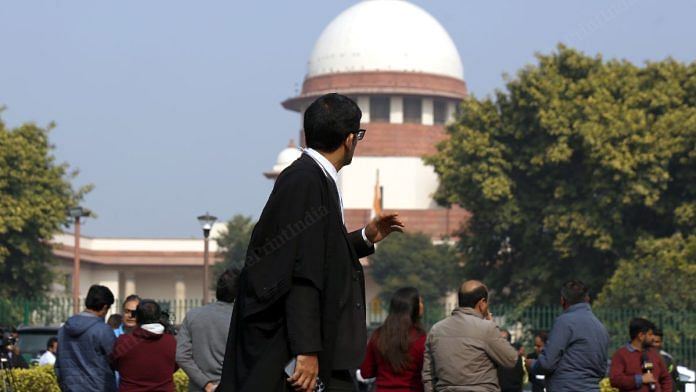New Delhi: Within a month of his takeover, Chief Justice of India Sanjiv Khanna has received two requests from the Supreme Court Advocates on Record Association (SCAORA), the Bar body that represents advocates-on-record practising in the top court, to reverse some of the decisions taken by his predecessor.
Advocates-on-record (AOR) are the Supreme Court lawyers who are officially responsible for filing petitions. The top court rules designate AORs to sign petitions from their end and official documents they file on behalf of their clients. A lawyer who has gained four years of experience in the field can become an AOR after clearing a written exam held by the Supreme Court. SCAORA is a body comprising AORs as members.
In its first letter to CJI Khanna—written on 2 December—SCAORA urged the CJI to reconsider two changes introduced in the court’s infrastructure during D.Y. Chandrachud’s tenure as CJI. The association and its members believe the changes do not align with the court’s historical ethos and history. These include a glass partition installed in the front corridor of the Supreme Court building—outside courtrooms 1 to 5—and an old library block for judges turned into a museum, which, the association says, is a security risk.
The second letter, sent to CJI Khanna Thursday, is about the decades-old practice of circulating adjournment letters, which former CJI Chandrachud stopped. The practice, the SCAORA letter said, allowed advocates-on-record to send adjournment letters to the court and the opposite side in advance to inform them about the unavailability of a counsel to argue on a date already fixed by the court. The system provided the court and the other side an explanation for the non-availability of counsel and an opportunity to reschedule a hearing considering the same.
The discontinuation of the practice, SCAORA said, has severely affected the members of the association, who, despite being indisposed due to genuine causes, can not request the court in advance to reschedule the hearing.
Nikhil Jain, the secretary of SCAORA, told ThePrint the association also attempted to contact the former CJI but received no positive response. “Objections were raised when the changes were being made. But no attention was paid to our concerns,” Jain said.
Speaking to ThePrint, SCAORA president Vipin Nair said that CJI Khanna’s office has assured the association of holding a meeting with its members. “We are likely to have a meeting soon to resolve the issues highlighted,” Nair said.
Meanwhile, the Supreme Court Bar Association (SCBA) shot off a letter Thursday to the CJI’s office, raising objections and concerns similar to that of the SCAORA about the glass partition and the museum.
Also Read: ‘If men menstruated, they would understand.’ SC slams sacking of women judges in Madhya Pradesh
Details of SCAORA letters to CJI Khanna
The letter related to the glass partition pointed to the cracks that have developed in the glass panels, which, the association said, poses a potential safety hazard to the lawyers and litigants using the corridor. Besides, the letter said that the panel was not only a “significant departure from the historical architecture and aesthetics of the court” but also caused severe impediments in the day-to-day access to the courtrooms in that area. The glass partition reduced the corridor space drastically, besides affecting the historic character of the building, it said.
The letter said the glass panel was to air-condition the corridor area outside courtroom number 1 where the CJI bench assembled. Despite acknowledging the work on the glass partition considered extreme heat conditions during the summer, the letter said stakeholders were not consulted before the work.
Reiterating its earlier demand to relocate the new judicial museum to a lower security zone within the top court, SCAORA, in its letter, said the new space within the high-security zone violated the top court’s rules restricting entry of the public into court premises.
A litigant can enter the high-security zone of the court complex only with a pass made on the recommendation of their AOR, who takes full responsibility for their client entering the premises.
While, on the one hand, the court has imposed strict security measures for litigants, the letter noted that it is permitting a public space, such as the museum, inside the court complex, creating not only a security risk to the building but also putting extra burden on facilities used by the stakeholders.
As for reviving the practice of circulating adjournment letters, SCAORA said informing judges and other sides in advance helped to avoid unnecessary delays and ensured effective use of the court’s time without causing any disruptions. It also allowed courts to manage their dockets (work lists) efficiently and avoided inconveniencing other parties involved in court proceedings.
The letter sought functioning guidelines for lawyers so that they circulate adjournment letters only under unavoidable circumstances.
(Edited by Madhurita Goswami)
Also Read: Days after homebuyers’ letter to CJI, SC directs states to grant clearances to Unitech projects






